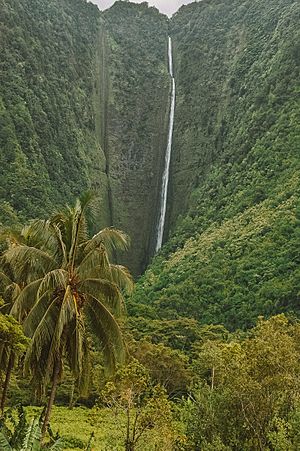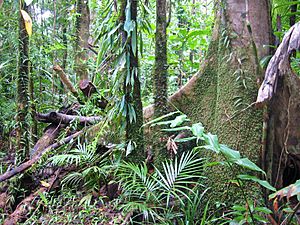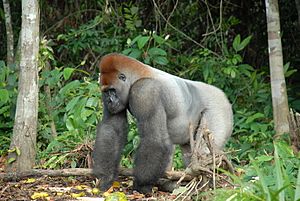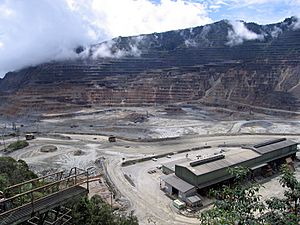Tropical rainforest facts for kids
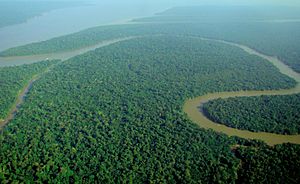
Tropical rainforests are special forests found in hot, wet places near the equator. They get a lot of rain all year round, with no dry season. Every month, they receive at least 60 millimeters of rain! You can usually find these true rainforests within 10 degrees north or south of the equator. They are a type of tropical forest that grows in the warm zone between the Tropic of Cancer and the Tropic of Capricorn.
Contents
What are Tropical Rainforests Like?
You can describe tropical rainforests in two words: hot and wet! The average temperature stays above 18 degrees Celsius (64 degrees Fahrenheit) every month. They get a huge amount of rain each year, usually between 1,750 mm (69 inches) and 3,000 mm (118 inches), but sometimes even more than 10 meters (394 inches)! Because of all this rain, the soil often doesn't have many nutrients, as the water washes them away.
Tropical rainforests are bursting with life! They are home to about 40% to 75% of all living species on Earth. Half of all the animals and plants on our planet live in rainforests. Two-thirds of all flowering plants grow there. Imagine, just one small area of rainforest (about the size of a soccer field) can have 42,000 different kinds of insects, over 800 trees of 313 species, and 1,500 types of larger plants! People even call tropical rainforests the "world's largest pharmacy" because more than a quarter of our natural medicines come from them. Scientists believe there are still millions of species of plants, insects, and tiny living things waiting to be discovered in these forests.
Sadly, tropical rainforests are among the most threatened places on Earth. Human activities are breaking them into smaller pieces. While natural events like volcanoes and climate change have caused changes in the past, fast human-caused destruction is a major reason why many species are disappearing. Throughout the 1900s, rainforests were heavily logged and cleared for farms. The area covered by rainforests around the world is shrinking very quickly.
How Old are Rainforests?
Tropical rainforests have been on Earth for hundreds of millions of years. Most of today's rainforests are found on pieces of a supercontinent called Gondwana from the Mesozoic era (the time of dinosaurs). When this land broke apart, it led to fewer kinds of amphibians but helped reptiles grow into many new species. Today, tropical rainforests are found in five main areas: tropical America, Africa, Southeast Asia, Madagascar, and New Guinea, with smaller parts in Australia.
Other Kinds of Tropical Forests
Some other types of forests look similar to tropical rainforests or blend into them:
- Moist seasonal tropical forest: These forests also get a lot of rain, but they have a warm, wet summer and a cooler, dry winter. Some trees here lose their leaves during the dry season. You can find them in parts of South America, Central America, around the Caribbean, in West Africa, parts of India, and across much of Indochina.
- Montane rainforests: These are found in cooler, mountainous areas. At higher elevations, they become known as cloud forests.
- Flooded rainforests: These are tropical freshwater swamp forests, also called "flooded forests." You can find them in the Amazon basin and other places.
Layers of the Rainforest
Rainforests have different layers, like a tall building, from the ground up to the treetops. Each layer is a unique home for different plants and animals that have adapted to live there. Only the very top layer, called the emergent layer, is unique to tropical rainforests.
The Forest Floor
The forest floor is the bottom layer. It gets very little sunlight, only about 2%. So, only plants that can grow in low light survive here. Away from rivers and clearings, the forest floor is quite open because not much can grow. This open space allows larger animals to move around easily, like okapis, tapirs, Sumatran rhinoceroses, and apes like the western lowland gorilla. Many reptiles, amphibians, and insects also live here. The forest floor is also where dead plants and animals decay very quickly because of the warm, wet conditions. Many types of fungi help break down this waste.
The Understory Layer
The understory layer is between the canopy (the main roof of the forest) and the forest floor. This layer is home to many birds, small mammals, insects, reptiles, and predators. Examples include leopards, poison dart frogs, ring-tailed coatis, boa constrictors, and many kinds of beetles. The plants here are usually shrubs, small trees, and large vines that can grow in the shade. Only about 5% of sunlight reaches the understory, so plants here rarely grow taller than 3 meters (10 feet). To deal with the low light, many understory plants have very large leaves. Many young trees that will eventually grow into the canopy start their lives in the understory.
The Canopy Layer
The canopy is the main layer of the forest, forming a thick roof over the layers below. It has most of the largest trees, usually 30–45 meters (98–148 feet) tall. These are tall, broad-leaved evergreen trees. The canopy has the most different kinds of living things. It's full of plants that grow on other plants, called epiphytes, like orchids, bromeliads, mosses, and lichens. These plants attach to tree trunks and branches and get water and nutrients from rain and bits of leaves that collect on the trees. Many animals live here, including birds like the yellow-casqued wattled hornbill, collared sunbird, grey parrot, keel-billed toucan, and scarlet macaw. Other animals include spider monkeys, the African giant swallowtail butterfly, three-toed sloths, kinkajous, and tamanduas.
The Emergent Layer
The emergent layer has a few very tall trees, called emergents, that grow above the main canopy. They can reach heights of 45–55 meters (148–180 feet), and sometimes even 70–80 meters (230–260 feet)! Some examples are Balizia elegans and Terminalia oblonga. These trees must be strong enough to handle the hot temperatures and strong winds high above the forest. Special animals live in this layer, such as the crowned eagle, the king colobus monkey, and the large flying fox.
Sometimes, the layers aren't always clear. Rainforests are always changing. For example, when a large emergent or canopy tree falls, it creates a gap in the forest. These openings are very important for new rainforest trees to start growing. It's thought that about 75% of tree species in places like Costa Rica need these canopy openings to sprout from seeds or to grow bigger than small saplings.
Rainforest Ecology
Rainforest Climates
Tropical rainforests are found near the equator, which means they have an equatorial climate. This climate is known for its warm temperatures and lots of rain all year. However, the amount of rain changes throughout the year, creating wet and dry seasons. Scientists classify tropical forests by how much rain they get, which helps them understand the differences between forests that look similar. Generally, true tropical rainforests get more than 2 meters (79 inches) of rain each year and have temperatures above 24 degrees Celsius (75 degrees Fahrenheit). The way a tropical forest grows and what lives in it are very sensitive to changes in climate, especially changes in rainfall.
Rainforest Soils
The soils in tropical rainforests can be very different, depending on the climate, plants, landscape, rocks, and how old the soil is. Most tropical soils have very few nutrients because the heavy rain washes them away. However, some areas do have fertile soils. The main types of soil in tropical rainforests are ultisols and oxisols. Ultisols are old, acidic red clay soils that lack important nutrients like calcium and potassium. Oxisols are also acidic, old, reddish, and have been heavily washed by rain, but they drain water better than ultisols. The reddish color of both soils comes from iron and aluminum oxides, which form due to the heat and moisture.
The soil's physical and chemical features are strongly linked to how much the forest grows and what it looks like. For example, the physical properties of the soil affect how quickly trees are replaced, while chemical properties like nitrogen and phosphorus control how fast the forest grows. The soils in the eastern and central Amazon and Southeast Asia are old and poor in minerals. But the soils in the western Amazon (Ecuador and Peru) and volcanic areas of Costa Rica are young and rich in minerals. Forests in the western Amazon grow the most wood, while those in the eastern Amazon, with their heavily weathered oxisols, grow the least.
Nutrient Recycling
The fast decay of dead plants and animals in rainforests happens because of phosphorus levels in the soil, lots of rain, high temperatures, and many tiny living things (microorganisms). Besides bacteria, many other decomposers like fungi and termites also help. This quick recycling of nutrients is important because the resources in the soil control how much the plants above ground grow and what kinds of plants live there. These soils often don't have enough phosphorus, which limits how much carbon plants can take in. Bacteria in the soil break down leaves and other organic matter into simple forms that plants can use. This process, called decomposition, releases carbon dioxide. High temperatures and rain speed up decomposition, so plant litter quickly decays, releasing nutrients that plants immediately absorb.
Buttress Roots
Many tropical rainforest trees have unique buttress roots. Instead of growing deep into the ground, these roots spread out widely near the surface. This helps the trees take up nutrients more efficiently in a soil that doesn't have many nutrients and where many trees are competing. Most of the nutrients in rainforest soil are near the surface because dead plants and animals decay so quickly. So, buttress roots stay at the surface to help trees get the most nutrients and compete with other trees. These roots also help trees take in and store water, increase the surface area for gas exchange, and collect leaf litter for extra food. They also help stop soil erosion and get more nutrients during heavy rains by guiding nutrient-rich water down the trunk. Plus, these large roots give great support and stability to rainforest trees, which often grow very tall, helping them stand strong during storms.
Biodiversity and New Species
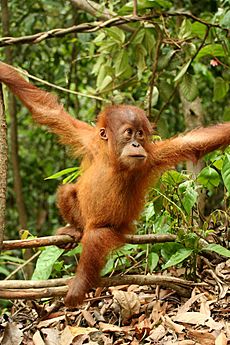
Tropical rainforests have an incredible variety of plant and animal species. Scientists have wondered for years why and how the tropics can be so diverse.
Competition Between Species
When many species with similar needs live in the tropics and resources are limited, they compete with each other. Species that "lose" the competition might disappear or find a new way to live. Strong competition can lead to one species taking over, causing another to go extinct. Another option is "niche partitioning," where species share resources by using different habitats, food sources, or behaviors. For example, two species might eat the same food but at different times of the day.
Refuges During Ice Ages
One idea, called the theory of Pleistocene refugia, suggests that during the last ice age, rainforests were broken into smaller patches by areas of non-forest plants. These patches were like safe havens, or "refuges." In these refuges, new species formed because the groups were separated. When the ice age ended and it became wetter, the rainforest expanded and the refuges reconnected. This idea is still debated by scientists, but genetic evidence suggests that some species did form new groups millions of years ago, even before the last ice age.
People and the Rainforest
Living in the Rainforest
Tropical rainforests have been home to humans for thousands of years. Many Indigenous tribes in South and Central America, the Congo Pygmies in Central Africa, and tribes like the Dayak people and Penan people in Borneo live there. Food in the forest is spread out because of the huge variety of life, and much of it is in the treetops, requiring a lot of effort to get. Some hunter-gatherer groups use the rainforest seasonally but mostly live in nearby savannas or open forests where food is easier to find. Other rainforest dwellers are hunter-gatherers who trade valuable forest products like animal hides, feathers, and honey with farming communities outside the forest.
Indigenous Peoples
Many different Indigenous peoples live in the rainforest as hunter-gatherers or small-scale farmers. They often trade forest products with people outside the forest. These Indigenous peoples have lived in rainforests for tens of thousands of years and have sometimes been so hidden that some tribes have only recently been discovered. These groups are greatly threatened by loggers looking for valuable tropical wood and by farmers wanting to expand their land for cattle and soybeans. In 2007, Brazil reported that it had confirmed 67 different uncontacted tribes, more than any other country.
The pygmy peoples are hunter-gatherer groups in equatorial rainforests known for their short height (usually under 1.5 meters or 59 inches). This group includes the Efe, Aka, Twa, Baka, and Mbuti people of Central Africa. However, the term "pygmy" can be seen as disrespectful, so many tribes prefer not to be called that.
Some well-known Indigenous peoples of the Americas include the Huaorani, Ya̧nomamö, and Kayapo people of the Amazon. Their traditional farming system, called swidden cultivation (or slash-and-burn), involves clearing small areas of forest. This method is often seen as not very harmful. In fact, some traditional farming practices, like using shade trees and letting land rest, help keep the soil healthy in the Amazon's nutrient-poor soils.
Asia also has diverse forest peoples, such as the Lumad peoples of the Philippines and the Penan and Dayak people of Borneo. The Dayaks are known for their traditional headhunting culture, which was part of certain rituals. Pygmies in Southeast Asia are sometimes called "Negrito".
Rainforest Resources
Foods and Spices We Eat
Many foods we enjoy today originally came from tropical rainforests. These include yams, coffee, chocolate, bananas, mangoes, papayas, macadamia nuts, avocados, and sugarcane. Most of these are still grown on large farms in areas that used to be rainforest. For example, in the mid-1980s and 1990s, people ate 40 million tons of bananas and 13 million tons of mangoes worldwide each year. Tropical forests have given us 250 different kinds of cultivated fruit, compared to only 20 from temperate forests. Forests in New Guinea alone have 251 tree species with edible fruits!
Ecosystem Services
Besides providing food and other products, rainforests also offer important "ecosystem services" that benefit everyone. They play a big role in keeping biological diversity alive, soaking up and storing carbon (which helps with climate change), regulating global climate, controlling diseases, and helping with pollination. For example, half of the rainfall in the Amazon comes from the forests themselves. This moisture is important for rain in Brazil, Paraguay, and Argentina. The destruction of the Amazon rainforest was a main reason for the severe drought in Brazil in 2014-2015.
However, the amount of carbon absorbed by the world's healthy tropical forests has decreased. A study in 2020 showed they took up a third less carbon in 2019 than in the 1990s, mainly due to higher temperatures, droughts, and deforestation. Scientists worry that typical tropical forests might start releasing more carbon than they absorb by the 2060s.
Tourism in Rainforests

Even though tourism can sometimes have negative effects, it also has several important positive impacts on tropical rainforests.
- In recent years, ecotourism (tourism that focuses on nature and conservation) in the tropics has grown. As rainforests become rarer, people travel to countries that still have these diverse habitats. Local people benefit from the extra money brought in by visitors, and areas that tourists find interesting are often protected. Ecotourism can encourage conservation, especially when it helps the local economy. It can include activities like watching animals, jungle tours, and visiting cultural sites or native villages. If done carefully, this can be good for both locals and the plants and animals.
- More tourism can mean more money for protecting the habitat. Money from park entrance fees can be used specifically to pay for protecting and managing sensitive areas. Taxes and tourism revenue also give governments a reason to put money into forest protection.
- Tourism can also help people appreciate the environment more and learn about environmental problems when they get closer to nature. This increased awareness can lead to more environmentally friendly behavior. Tourism has helped wildlife preservation and protection efforts, especially in Africa, but also in South America, Asia, Australia, and the South Pacific.
Protecting Rainforests
Threats to Rainforests
Deforestation
Mining and Drilling
Valuable metals like gold, silver, and coltan, as well as fuels like oil and natural gas, are found under rainforests around the world. These resources are important for developing countries, and getting them out is often a top priority for economic growth. Mining and drilling can require clearing large areas of land, directly causing deforestation. In Ghana, a country in West Africa, decades of mining left only about 12% of the country's original rainforest.
Clearing Land for Farms
When humans developed agriculture, they started clearing parts of the rainforest to grow crops, turning it into farmland. People who live this way get most of their food from these cleared farm plots and also hunt and gather in the forest. The challenge is balancing the needs of a farmer providing for their family with the needs of the whole planet. This problem hasn't improved much because no plan has been made to help everyone involved.
Farming on land that used to be forest can be difficult. Rainforest soils are often thin and lack many minerals, and heavy rainfall can quickly wash away nutrients from cleared areas. Some groups, like the Yanomami of the Amazon rainforest, use slash-and-burn farming to deal with these problems and move deeper into rainforest areas. However, these are not true rainforest dwellers; they live on cleared farmland and go into the rainforest to hunt and gather. Up to 90% of the typical Yanomami diet comes from farmed plants.
Some solutions have been suggested, like letting the land rest for a while so secondary forest can grow back and make the soil healthy again. Good practices like restoring and conserving soil can help small farmers grow more food on smaller pieces of land.
Climate Change
The tropics play a major role in reducing carbon dioxide in the air. Tropical rainforests, especially the Amazon rainforest, are called carbon sinks because they absorb a lot of carbon. As major carbon absorbers and stores of carbon and soil methane, their destruction adds to increasing global warming gases. Climate change has been greatly affected by the destruction of rainforests. One study showed that if all rainforests in Africa were removed, the air temperature would increase by 2.5 to 5 degrees Celsius (4.5 to 9 degrees Fahrenheit).
Protecting Rainforests
Many different efforts are being made to protect and save tropical rainforest habitats. Tropical rainforest conservation includes everything from strictly protecting areas to finding ways for people living in rainforests to use them sustainably. International policies have also created programs like Reducing Emissions from Deforestation and Forest Degradation (REDD), which gives companies and governments a way to offset their carbon emissions by investing money in rainforest conservation.
See also
 In Spanish: Selva tropical para niños
In Spanish: Selva tropical para niños



